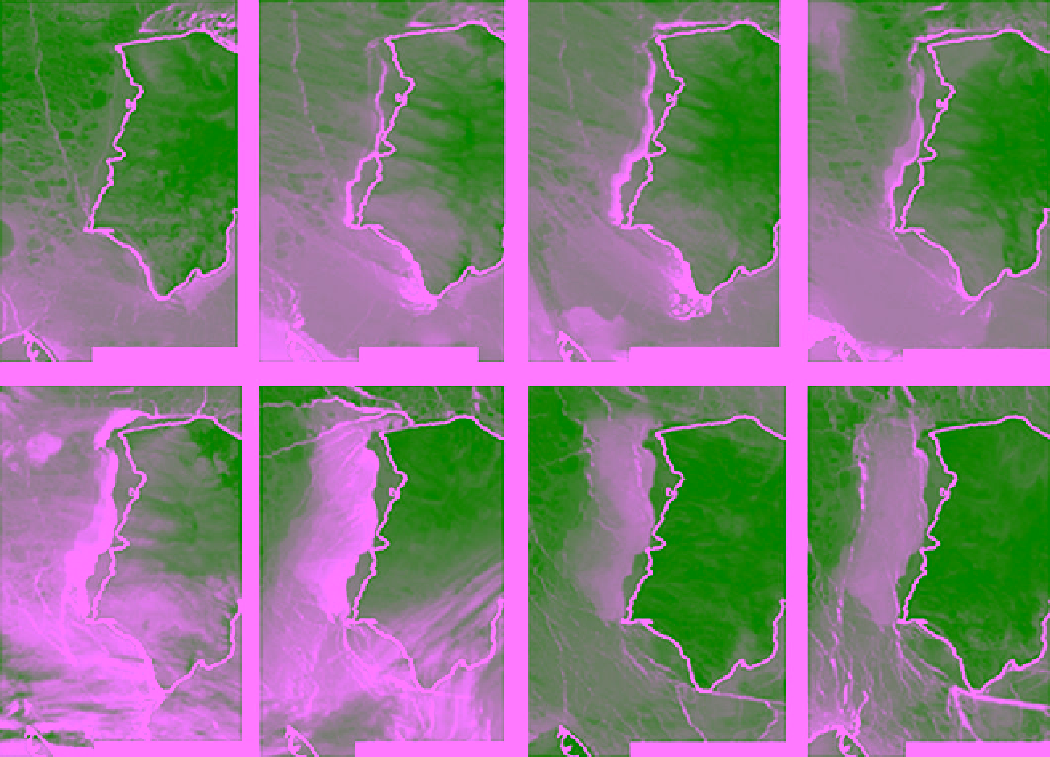Geology Reference
In-Depth Information
2 Dec. 1993
3 Dec. 1993
4 Dec. 1993
6 Dec. 1993
Banks Island
Banks Island
Banks Island
Banks Island
93-12-02-0036 cb4
93-12-03-0334 cb4
93-12-04-0312 cb4
93-12-06-1416 cb4
16 Dec. 1993
19 Dec. 1993
7 Dec. 1993
13 Dec. 1993
93-12-07-2114 ch4
93-12-13-1450 ch4
93-12-14-1743 ch4
93-12-19-1537 ch4
Figure 2.66
Series of AVHRR images showing the opening of the coastal polynya of Banks Island. The first sign of the opening is
observed in the December 3, 1993 image. The polynya continued to expand due to wind action. The largest area is observed in
the December 13 image. The image of December 19 shows the polynya fully covered with thin ice. All images are cloud‐free
(M. Shokr, unpublished data).
polynya. This leaves the ocean surface exposed to the
cold atmosphere, and therefore triggers formation of new
ice that will be removed again and the process continues.
That is why polynya is viewed as an “ice factory.” In
general, sensible heat polynyas are less persistent in
occurrence than latent heat polynyas. It is possible that
the two mechanisms become active in the same polynya
as in the case of NOW.
A recurring coastal polynya in the Arctic has been
observed along the west coast of the Banks Island,
located in the Beaufort Sea. It is shown in the series of
the AVHRR images in Figure 2.66. Offshore wind breaks
the fast ice along a weak boundary and pushes it away
from the coastline. The breakup is shown in the image of
December 3, 1993, and the full opening of the polynya is
visible in the image of December 13, 1993. It is possible
in the case of coastal polynya that ice is pushed back by
onshore wind to close the polynya. This cycle of opening
and closing has been observed in the Banks Island pol-
ynya. Most of the polynyas in the Antarctic region are
coastal polynyas.
An event that usually accelerates and maintains the
creation of polynya is the formation of what is known
as an “ice arch” or “ice bridge.” This phenomenon occurs
when ice continues to drift through a relatively narrow
passage into a wider water area that is geophysically
qualified to become a polynya on the ground of warm
upwelling water or strong wind. If the flow of ice blocks
the passage between two constriction points then an
ice arch will form between the two points. The arch is a
mechanically strong structure, and therefore it causes the
upstream ice flow to stop. This will further facilitate the
formation of a polynya downstream the arch when one or
both of the aforementioned mechanisms become active.
Figure 2.67 shows two polynyas in the eastern Arctic
(indicated by the arrows) with visible ice arches: the NOW

